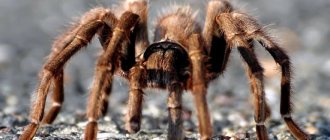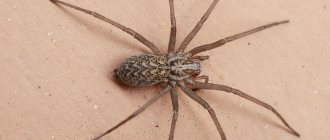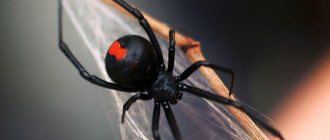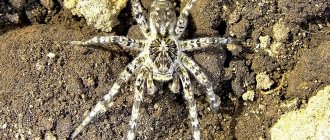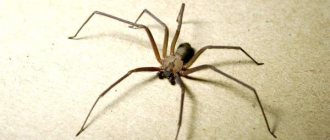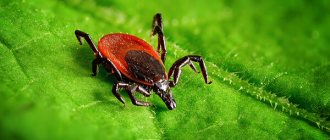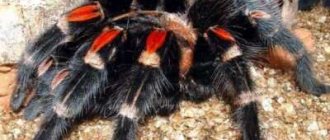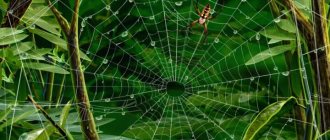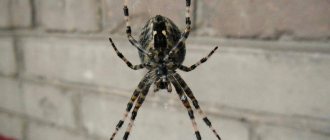Not everyone knows how many legs a spider has, because it seems like there are a lot of them because of fear, the answer is always clear - 8. There are many species of “arachnids” on our planet. In addition, some species are very poisonous, and many of them are completely safe.
It should be noted that there are species that live in human homes as pets. Why not, especially since they eat little and leave virtually no waste.
Spider legs structure
The legs, or as they often say paws, vary in length and thickness depending on the type of spider. But their structure is the same. The segments, also known as parts of the leg, consist of a number of parts:
- pelvic;
Spider structure.
- trochanter;
- femoral part;
- knee part;
- shin;
- calcaneal segment;
- paw.
claw
There is a claw segment that is not separated from the paw, so they are not separate.
Hairs
The hairs that completely cover the legs act as an organ of touch.
Length
The first and fourth pair of legs are the longest. They are walking. The third ones are the shortest.
How many fingers does a chicken have?
Fine
The usual number of fingers for hens and roosters is four. Three of them look forward, one looks back. This position allows individuals to maintain balance.
You can find animals with a large number of fingers. A rooster with a spur is often mistaken for a “five-fingered rooster.” Although it is formed from a hard growth, it cannot perform the functions of a finger.
Pedigree trait
There is a breed of chickens whose characteristic feature is the presence of five fingers. This is a fireball.
The homeland of birds is France. Initially, the breed was bred only for eggs and meat. But today it is considered decorative and participates in various exhibitions.
A chicken with four fingers is immediately discarded. Roosters of this species have spurs, which is why they are often mistaken for “six-fingered”. A full description is given in the article “Description of the Faverol chicken breed.”
Deviations
Another common reason for the presence of “extra” fingers in chickens and roosters is genetic abnormalities.
This happens when closely related chickens reproduce multiple times. In this case, there may be more than five fingers. Their number will also not be the same on different paws.
Such chickens are not considered a reject. Their productivity is not inferior in terms of indicators to “ordinary” representatives of their breed.
But you should not use chickens and roosters with genetic abnormalities in further breeding. Otherwise, the next generation will differ even more from the norm.
Limb functions
The abdominal limbs are walking. They are long and allow spiders to move quickly and jump high with spring. The spider's movement looks smooth from the outside.
This is possible due to the fact that pairs of legs have certain functions: the front ones pull up, and the back ones push. And from different sides there is movement in pairs, if the second and fourth pair are rearranged on the left, then the first and third are on the right.
Interestingly, when they lose one or two limbs, spiders also move actively. But the loss of three legs is already a problem for arachnids.
Execution cannot be pardoned
There are several signs that tell what the killing of a spider promises, and there are even some that contradict each other. But today we will move away from popular beliefs and look at several theories that, as it seems to us, are ways to explain why you should not kill spiders.
- According to legend, once upon a time a spider's web saved a man's life. He was persecuted and, forced to flee, hid in a cave, which was almost completely entangled in spider webs. The pursuers were never able to find the fugitive; they didn’t even bother to examine the cave - there were so many cobwebs in it.
- The second version, which tells why you should not kill spiders in the house, is based on their active use in folk medicine of past times. In ancient times, healers mainly used various decoctions and infusions to heal the sick, to which they added not only herbs, but also insects. Often the role of a healing “ingredient” was a spider, ideally poisonous. They treated with poison, so killing a spider without any serious purpose promised the rapid development of the disease.
- The third legend says that spiders attract happiness - it gets entangled in their web and remains in the house. And the owner of the fishing nets, who has settled in a residential building, is a symbol of good news and prosperity. For this reason, killing a spider means driving away happiness from the house - there will be no one to spin the web and all the good things from the house will soon “fly away” along with the last silk threads.
Small house spiders are not capable of causing harm to human health
And if there are several of them, then this is a reason to pay attention to the cleanliness of your own home. In this situation, it is not the spiders that should be destroyed, but the reason why they ended up in the apartment
Remember, spiders will always live where there is food for them.
For many people, spiders cause fear and some kind of hostility. I treat them with indifference. I won’t say that I’m afraid of them, but I don’t feel love for them either. Outside my window there is a tree with lush foliage; in the summer, one small spider settled there. One day I was watching him and noticed some peculiarities. I think you will also be interested in learning about them.
Pedipalps and chelicerae
The entire body of the spider consists of two parts: the cephalothorax and abdomen. Above the mouth opening there are chelicerae, covering the fangs and holding prey, and next to them are the pedipalps. These appendages are so long that they are confused with limbs.
Pedipalps. Processes near the chewing outgrowth, which serve two purposes: orientation in space and fertilization of females.
Chelicerae. They are like little claws that inject poison, grind and knead food. They pierce the body of the victim, they are mobile from below.
Spider legs.
Hairs
There are hairs along the entire length of the spider's legs. Depending on the type, they can differ in structure; they can be smooth, protruding and even curly. On the heels of the fourth pair of legs there are thickened bristles in the form of a comb. They are used to comb webs.
Spider hairs.
Hairline
The body of the flycatcher is covered with a hard chitinous armor shell.
Its name is exoskeleton. It performs several functions at once:
- protects internal organs from mechanical influences;
- serves as a buffer between nature and the predator’s body;
- strengthens most muscles;
- plays the role of a supporting frame.
Hairs and bristles grow on the exoskeleton, performing protective, sensory and tactile functions. Webmasters have no ears. They hear using hairs located on their legs. By catching waves emanating from a sound source, the spider quite accurately determines the location of the object. The number of hairs on the sole of the paw reaches several thousand.
The nervous system of a predator includes only 2 nerve ganglia, but the volume of the brain occupies from 20 to 30% of the cephalothorax. Surprisingly, these creatures can even distinguish colors, and special sensitive hairs on their legs help them recognize odors. Arthropods also have chemically sensitive hairs on their limbs. With their help, the fly catcher determines whether his prey is poisonous.
The life of a spider is eventful. To feed, he has to constantly weave nets and catch prey. Over time, the exoskeleton wears out, and the predator replaces it by molting. Along with the chitinous armor, the hairline also changes. If the spider's leg was previously torn off, a new one will grow during the molting process.
How long is a spider's leg?
The length varies from minimum to maximum depending on living conditions and lifestyle.
Haymaker.
Harvesters, often thought to be spiders, are actually false spiders with very long legs and a gray body.
There are several record holders:
- Brazilian wandering spider - more than 15 cm;
- Baboon - more than 10 cm;
- Tegenaria - more than 6 cm.
It happens that even in the same species of spider, under different living conditions, the size and length of the legs vary.
A little about nutrition
Quite often, people are sincerely surprised and cannot understand what spiders eat in their apartment, where there are no insects
In this case, it is important to remember one thing - even if you are sure that no one lives in your house except you, the appearance of spiders always indicates the opposite
If a spider came into your house and wove a web in it, it means that there is a victim nearby that can fall into it. You may not see these small insects, but at least someone definitely lives in any apartment (provided that you do not chemically disinfest it every week).
Spiders living in apartments are insectivores and eat almost everything with legs, antennae and wings:
- silverfish can live quietly under your bathroom;
- in the kitchen where there is a vase of apples, tiny fruit flies can settle;
- food pantries often contain various beetles that eat cereals, flour, etc.;
- in addition, it could be flies and mosquitoes, insect larvae and other spiders accidentally flying in from the street.
This is interesting! By eating insects, spiders bring us great benefits. And if the latter did not exist, then in the abundance of the former we would simply choke!
More about butterflies
This insect belongs to the species of arthropods; it is the most developed among invertebrates. There is hardly a person who would look indifferently at such a beautiful insect. She has a complex “life path”; she goes through a metamorphosis from a crawling caterpillar to a butterfly.
Back in the nineteenth century
Scientists classified butterflies as various insects, but soon experts put everything in its place. Currently, more than 110,000 types of butterflies have not been studied.
Using hives as an example, this article will look at how many legs a butterfly has, and how they transform from a caterpillar.
Urticaria is most often found in the area
Russian Federation, she is a representative of the nymphalid family.
Where can you find hives:
- North America;
- Asia;
- Europe;
- Japan;
- China.
Urticaria gets its name from its love of food in the form of nettles. In the fall, the male wren dies, and the females remain to spend the winter in various sheds, basements, crevices and other hidden areas. In winter, urticaria wraps its wings around its body like a blanket. Sometimes it freezes completely, becoming like a piece of ice.
Urticaria belongs to a small species of light-winged beauties
, which overwinter as adults. The butterfly comes out of hibernation early, this happens in April.
About arachnophobia
Science knows more than 40 thousand species of spiders. Some stand out for their size, others for their toxicity, and others for their color. But at the same time, for the majority, the appearance of absolutely all arachnids is unattractive, and some experience panic fear of them. Such people are called arachnophobes.
But why are people afraid of spiders? After all, if you look at it, the arachnid has much more reasons to fear a person - he has much less chance of causing us any harm than we have in relation to him. Thus, the phobia itself seems somewhat irrational.
There is a theory that the fear of spiders dates back 350 million years ago, to a time when humans did not yet exist. Fossil arachnids were mostly poisonous and posed a serious threat to primates. As a result, the latter developed a reflex of situational readiness - when a spider appeared, they were forced to hide with lightning speed. Over time, the number of deadly species became much smaller, but the instinctive fear remained. Thus, it turns out that arachophobia developed as part of human evolution.
Classification
There is no uniform classification system for spiders. One can only correlate their specific types by density of distribution, rarity of a particular species, safety or threat to human life, and size.
Safe spiders
This species includes representatives of the animal world that do not harm people. They are either unable to bite through the skin at all, or their venom does not pose any threat.
These arachnids include:
- crosses,
- tarantulas,
- haymakers (mowers),
- horses,
- brownies.
Cross spider
Deadly poisonous
In most cases, spiders do not pose any threat to humans. Especially if you don't try to deliberately anger him. But there are also those with whom it is better not to meet.
Arachnids that are truly poisonous and dangerous:
- karakurt,
- black Widow,
- Brazilian Runner Spider,
- banana Spider,
- brown recluse.
Brown recluse spider
Rare
Some spiders can be found everywhere, while others are very rarely seen.
Such distinctive arthropods include:
- nephila-goldweaver,
- baboon spider,
- sydney spider Funnel Web,
- Colombian purple tarantula,
- phalanx spider,
- giant crab.
Golden spider
Little ones
Like all representatives of the animal world, spiders tend to vary in size. And if large arthropods evoke fear and disgust, then baby spiders can even evoke tenderness.
These babies include:
- anapistula,
- patu digua,
- side walker,
- Kipling's Bagheera
- Abacarus histrix.
Sidewalk spider
Large
And next to these little ones live real giants who are impossible not to notice.
Particularly large species:
- tarantula Theraphosa Blonda,
- orb-weaver-nephila,
- tarantula,
- giant crab,
- banana spider.
Tarantula
About being close to people
Spiders are most active in those places where food is abundant. The spider's diet will depend on its species, but mainly insects. There are quite a lot of the latter in the wild in the warm season, but even in summer spiders are often found in residential areas.
So, why does this happen - why do spiders appear in the apartment? There are several explanations for this.
Again an abundance of insects. These could be cockroaches, bedbugs, ants and other domestic animals that multiply quickly and constantly move throughout all rooms. Unsanitary conditions. Cluttered balconies, irregular cleaning of the house, fungus and mold in the corners - all this is ideal soil for the active reproduction of potential food for spiders. High humidity
Most often, high humidity occurs in apartments located on the ground floors, as well as in private houses with poorly installed floor coverings. Plus, if there is a basement or cellar nearby, and the windows face the shady side, then this only aggravates the situation
Such conditions are attractive to many insects, after which spiders will certainly follow.
Where do spiders come from in an apartment? They enter living spaces through ventilation shafts, through cracks in window frames, or simply on the owners’ clothes. Moreover, in the latter option, you can bring into your home not the spider itself, but its clutch, from which small spiders will subsequently hatch. And if there is something for them to enjoy in your apartment, they will happily stay.
This is interesting! Typically, spiders weave their webs where the victim is supposed to fall into it. Thus, you can independently establish the epicenter of the breeding of domestic insects, which will help get rid of the nest and the entire colony of uninvited guests!
Who settles next to us
Now let's find out which spiders live in apartments. The following can perfectly exist next to us:
- The haymaker spider, also known as the window spider or centipede. Its body can have a different structure, which depends on the subspecies, and different sizes - from 0.2 to 1 cm. It has very long legs - about five times longer than the length of the body. The haymaker spider weaves its webs in corners, often on window frames, and, standing upside down, waits for prey to fall into them. As soon as the victim becomes entangled in the web, he immediately appears near her, bites and injects poison. This is interesting! Cannibalism is observed in hay spiders. For example, in winter, when there are practically no insects, it no longer weaves a web, but goes in search of food on its own. It finds the web of another spider and begins to create vibrations, and when the owner comes running and is about to attack, the centipede rushes at him, entangles him in the web with its long legs and bites him! The harvest spider can be recognized by its very long legs and dark knee segments
- House spider. This arthropod has a yellowish body with a brown pattern. The size of females ranges from 0.7 to 1.2 cm, males are smaller - from 0.6 to 0.9 cm. The house spider is also a fairly common neighbor of humans, and its trapping nets are funnel-shaped.
Sometimes so-called hobo spiders penetrate into living spaces. They do not weave trapping nets and hunt exclusively on the move - they rush at their prey in one swift leap. However, they do not stay in apartments for long and leave after eating the caught prey.
This is interesting: The external structure of a spider, special abilities to survive
Interesting Facts
In Russia there are over a thousand types of arthropods. There are also dangerous varieties among them. It is noteworthy that all web masters are poisonous, but few pose a danger to humans. The most toxic of them are Karakurt and South Russian tarantula. They bite only if they feel a threat coming from people, so you should not provoke them to show aggression.
The lifespan of spiders varies. House flycatchers live from several months to a year. An ancient sign says that they appear in homes where there is money. In nature, arthropods live longer. Some representatives of Africa and South America live up to 15 years, and a female tarantula can live in a favorable environment for more than 20 years.
As for height, the champions are Goliath, who grows up to 30 centimeters, and the female Brazilian giant tawny tarantula, whose leg span reaches 26 centimeters. The most toxic in the world is also the representative of Brazil - the Traveling Spider. The result of its bite is paralysis and, less commonly, death. Children are especially vulnerable.
The respiratory organs of spiders vary and look quite peculiar. Some breathe using the trachea. Oxygen is delivered to the tissues through special openings (spiracles). Others have lung sacs that, thanks to the plates, resemble book pages.
The blood of arachnids is transparent, turns blue in the air and has nothing in common with human blood. Accordingly, these predators do not have a circulatory system. But some of them are capable of jumping a distance exceeding their body length by 50 times. You can meet fly and mosquito catchers everywhere except Antarctica, where there are extreme frosts.
